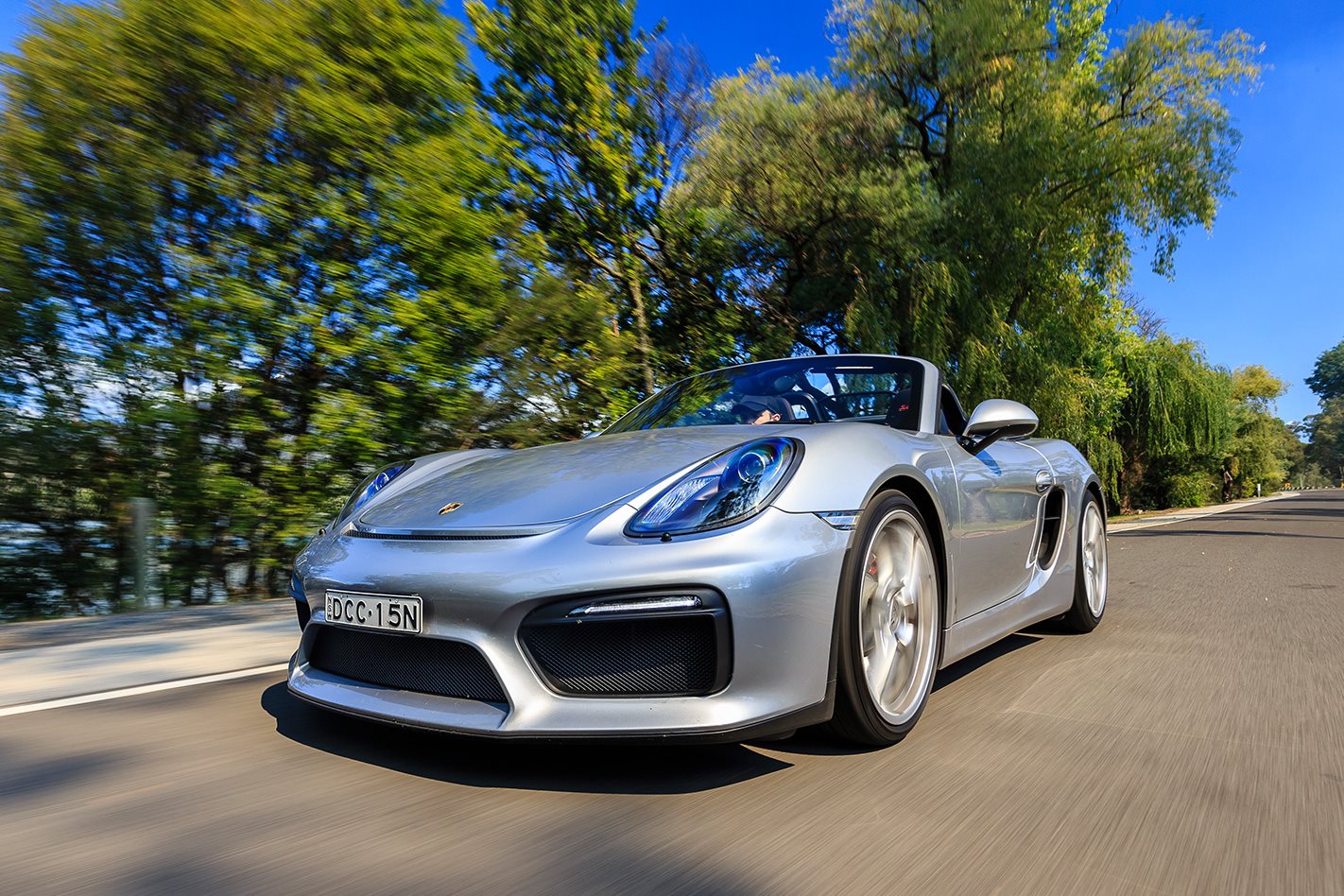I hate spiders. Always have. Big or small, deadly or harmless, doesn’t matter, I wish every one of these eight-legged freaks would disappear off the face of the planet. Spyders, however, are a different matter, particularly when there’s a Porsche badge on the front.
Instead of long, spindly legs and eight tiny eyes, the Boxster Spyder has a detuned version of the previous generation 911 Carrera S’s 3.8-litre flat-six. Producing 276kW/420Nm, it lifts Porsche’s roadster to new performance heights, devouring 0-100km/h in 4.5sec and powering on to a 290km/h top speed.
With the imminent arrival of the new turbocharged 718 Boxster (see p52), this might be the final naturally aspirated version of Porsche’s open-top sportster, and if so it’s going out on a high. The Boxster is a top-notch sports car in any guise, but as sweet as the smaller flat-sixes are, they tend to be an accompaniment to the chassis rather than the main event.
The larger, more powerful engine balances the grunt-to-grip equation somewhat, though it still needs to be extended to give its best. It’s content to trickle along in sixth gear at 60km/h and pull cleanly from virtually idle, but if you’ve become used to modern turbocharged torque, the need to pile on revs to make progress will feel unfamiliar at first.
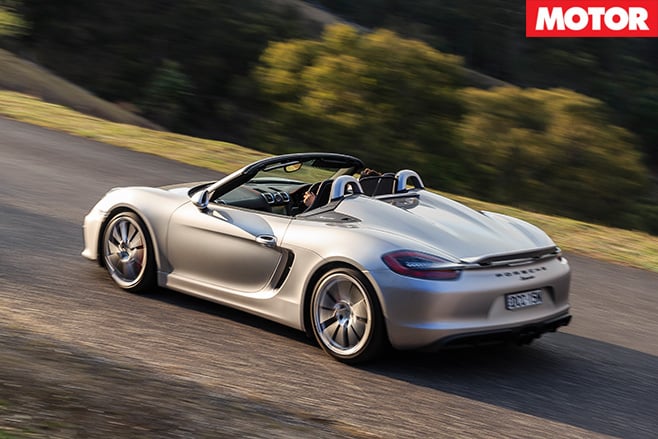
And like Barnsey in his Cold Chisel prime, the Boxster is also incredibly loud with the sports exhaust activated, which is fantastic but does make you a bit conspicuous on a hard drive. Thankfully, with the exhaust button deactivated it’s markedly quieter, to the point that tyre roar becomes the dominant noise when on a cruise.
Purists will be pleased to note that the means of controlling this delicious engine is via a six-speed manual only. The clutch is surprisingly heavy and the gearchanges do require some effort, but the speed and slickness with which each gear slots home – up or down changes – is sublime.
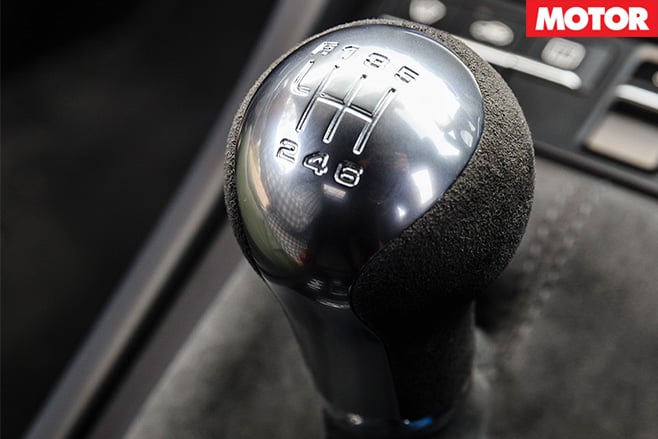
Unfortunately, the biggest problem with the Spyder is the same one that affects all Boxsters and Caymans, incredibly tall gearing. While the extra power means it certainly doesn’t struggle to accelerate, the intergalactic ratios deny you the opportunity to use both the engine and gearbox to their full potential, particularly on public roads.
Put it this way, if your favourite twisty road has a 100km/h limit and you wish to remain a law-abiding citizen – which obviously we all do – you can enjoy the Boxster Spyder until 5800rpm in second gear (cutout is 7800rpm). Subsequently, you’re rarely using that excellent gearbox, as second gear (which stretches to 134km/h) is more than enough for most roads. It doesn’t spoil the car by any means, but equally it would be a faster, more involving car with a shorter diff ratio.
Of course, the Boxster Spyder isn’t Porsche’s first mid-engined model to receive the 911 engine treatment, however it’s not an open-top Cayman GT4. Unlike its hardtop sibling, the Spyder is not a product of Porsche’s motorsport department and doesn’t benefit from the GT4’s extensive chassis and aerodynamic upgrades.
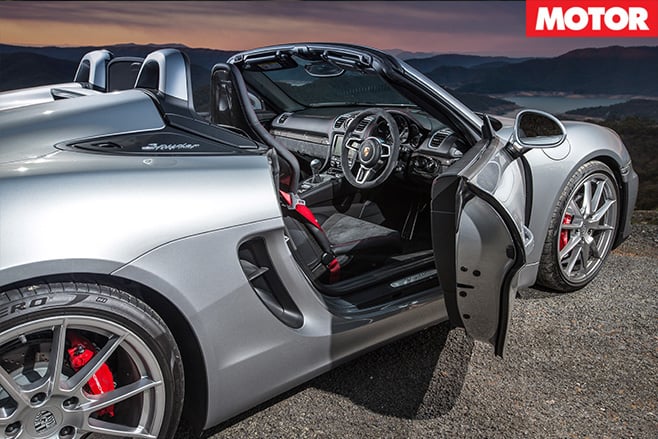
Grip levels are still huge – you can commit to corners with enormous confidence – but the car will now gently slide under power at the rear, especially if the corner exit is off camber. The steering is lighter, faster (it uses the 911 Turbo rack) and perhaps a little more communicative than the proper GT cars and makes correcting these movements a breeze.
As with all Porsches – well, the sports cars at least – it refuses to wilt no matter how hard you drive it, and as the tyres get hotter you can use the throttle to steer the car more, though the Spyder’s ESP system doesn’t feel as permissive as in the likes of the GT3. It’s also possible for the low nose to make some wince-inducing scuffs as it kisses the road over bumps at speed, which can limit how hard you can attack.
It’s all relative, however, and in the overall scheme of things these foibles are tiny blemishes. As a driver’s car the Boxster Spyder is sublime in almost every way. It feels fantastic in isolation, but it’s only in comparison that you realise just how good it is.
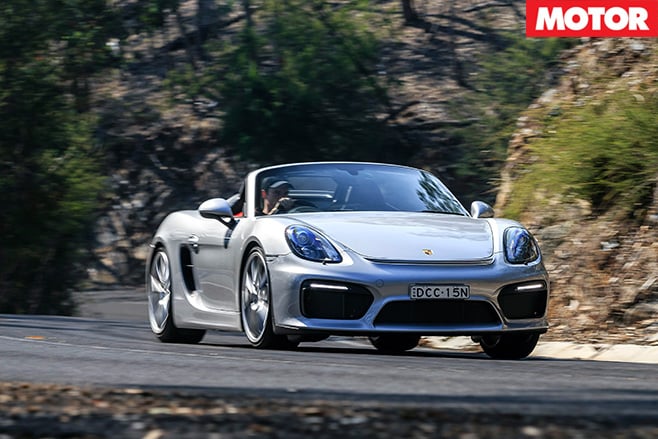
Of course, such of what makes the Spyder great can also be found in the regular $104,500 Boxster, which makes the $64,500 premium pretty steep, especially as you trade the practicality of the base car’s electrically-folding roof for a manually-operated arrangement which, while a big improvement on the previous Spyder’s tent-like affair, is still a bit of a faff.
However, such is its depth of ability and character, not to mention its rarity (just 35 or so will come to Australia), that $200,000 or more would still seem like reasonable value, which makes the current ask seem somewhat of a bargain.
Yes, the $20,000 cheaper Boxster GTS is fantastic, but if you can make the stretch its bigger brother is well worth the extra. Eight-legged spiders might be horrific, but six-cylinder ones are superb.
5 OUT OF 5 STARS
LIKE: Everything. Engine, handling, brakes, looks, noise, etc
DISLIKE: Limited supply; gearing too long
SPECS Engine: 3800cc flat-6, DOHC, 24v Power: 276kW @ 6700rpm Torque: 420Nm @ 4750-6000rpm Weight: 1315kg 0-100km/h: 4.5sec (claimed) Price: $169,000


